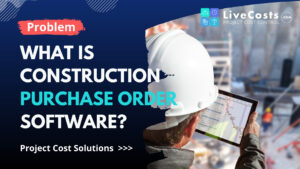Introduction
Construction is competitive, and traditional accounting software has limits that hold your company back.
As a construction cost tracking software company, we at LiveCosts see every day how traditional accounting software falls short of what’s needed for the construction industry. Inefficient processes and limited visibility into project finances slow you down.
By using an agile project cost tracking system instead, construction SMBs can have total control over project costs, optimise their resource allocation, and make informed decisions that drive profitability.
It’s time to break free from traditional accounting software and embark on a new era of financial success in the construction industry.
Here’s what our experience tells us that construction businesses need from an agile cost-tracking system that will help your business to grow.
What Features Should A Cost-Tracking System Have?
A cost-tracking system suitable for the construction industry will have these 6 features:
1. Real-Time Data Integration: The First Pillar of an Agile Project Cost Tracking System
Real-time data integration lies at the core of an agile construction project cost tracking system.
With this capability, construction SMBs can ensure that project cost information is captured and updated in real-time, providing them with immediate visibility into cost fluctuations, budget updates, and the overall financial health of their projects.
By seamlessly integrating data from various sources such as purchase orders, invoices, timesheets, and subcontractor billing, the system ensures accurate and up-to-date tracking of project costs against their granular budget.
Gone are the days of relying on manual data entry and cumbersome reconciliations. An agile project cost tracking system automates the integration of data from disparate sources, eliminating the risk of human error and reducing time-consuming administrative tasks.
This integration enables construction SMBs to access a comprehensive and unified view of their project costs in real-time, empowering them to make timely and informed decisions.
By capturing cost information in real-time, construction SMBs can promptly identify cost overruns or potential savings opportunities. They can proactively manage their budgets, taking corrective actions as needed to keep projects on track. Real-time data integration also facilitates accurate forecasting, as project managers and stakeholders can analyse the latest cost data and make adjustments accordingly.
Moreover, the system’s ability to integrate data from various sources ensures that no cost component goes unnoticed. It captures the intricacies of project costs, including labour expenses, material costs, equipment rentals, owned equipment costs, subcontractor fees, and other relevant expenditures.
This holistic approach enables construction SMBs to gain a comprehensive understanding of their cost breakdowns, empowering them to allocate resources more efficiently and make data-driven decisions to optimise project profitability.
In summary, real-time data integration is the backbone of an agile project cost tracking system.
By capturing and integrating project cost information in real-time from multiple sources, construction SMBs can enjoy immediate visibility into cost fluctuations, maintain accurate budgets, and make informed decisions to drive project success.
With this capability, construction SMBs can effectively navigate the complexities of cost tracking, enhance financial control, and achieve greater profitability in their construction projects.
2. The Key Role of Procurement in Agile Project Cost Tracking
It is essential to highlight the significance of procurement in the overall project cost tracking process. Procurement plays a crucial role in project cost management, and its integration into an agile project cost tracking system is vital for construction SMBs.
Effective cost tracking starts with procurement and plays a key role in maintaining accurate and up-to-date project cost information. By integrating procurement processes into an agile project cost tracking system, construction SMBs can streamline cost tracking from the very beginning of a project until its completion.
This information is often siloed in emails and spreadsheets when it should be accessible by all stakeholders in one place.
Procurement involves the acquisition of goods, services, and resources necessary for construction projects. It encompasses activities such as sourcing, supplier selection, purchase order creation, and contract management.
Each procurement transaction contributes to the overall project cost and needs to be accurately captured and tracked.
An agile project cost tracking system allows for seamless integration of procurement data, ensuring that procurement transactions are immediately reflected in the project cost tracking process. It enables construction SMBs to capture procurement-related costs, including material purchases, subcontractor fees, equipment rentals, and other expenses, in real-time.
By tracking costs starting from procurement, construction SMBs gain complete visibility into the financial impact of procurement decisions on project budgets.
They can monitor procurement expenses, compare them to the planned budget, and identify any deviations or cost overruns early on. This empowers project managers and stakeholders to make informed decisions regarding procurement, such as negotiating better prices, optimising vendor relationships, or adjusting the project budget to accommodate changing costs.
Furthermore, integrating procurement into an agile project cost tracking system allows for efficient cost reconciliation. Construction SMBs can easily match procurement transactions with invoicing and payments, ensuring accurate and timely financial records. This level of integration enhances accuracy and reduces the risk of errors or discrepancies in cost tracking.
In summary, effective project cost tracking begins with procurement. Integrating procurement into an agile project cost tracking system ensures that costs related to procurement activities are captured and tracked in real-time. By streamlining cost tracking from procurement to project completion, construction SMBs can optimise financial control, proactively manage costs, and make informed decisions that drive project success.
3. Mobile Accessibility
Mobile accessibility has transformed how construction professionals track various aspects of project costs, including labour hours, purchase orders, and the delivery of goods from the site.
The site-team play a huge role in collecting cost data, so involving them in the cost tracking process makes a great deal of sense. With mobile devices at their fingertips, construction teams can conveniently enter and track labour hours in real-time, eliminating the need for manual timesheets or delayed data entry.
This allows for accurate and up-to-date labour cost tracking, enabling project managers to monitor workforce productivity and make timely adjustments as needed. Additionally, mobile accessibility facilitates the creation and management of purchase orders directly from the site. Construction professionals can generate purchase orders on their mobile devices, select suppliers, and specify quantities, ensuring efficient procurement processes.
They can also track the delivery of goods right from the site, updating the system in real-time as materials or equipment arrive, providing visibility into inventory levels and enabling effective cost control. Mobile accessibility empowers construction teams to streamline these critical cost tracking activities, reducing paperwork, improving data accuracy, and enhancing overall project efficiency.
4. Granular Expense Categories
Granular expense categorisation is a fundamental aspect of effective project cost tracking in the construction.
By breaking down expenses into specific categories, construction professionals can gain a comprehensive understanding of where project costs are allocated and identify areas for potential cost optimisation.
Granular expense categorisation involves classifying costs into detailed subcategories such as labour, materials, equipment, subcontractor fees, permits, and overhead expenses.
This level of categorisation enables construction businesses to track and analyse expenses with precision, facilitating accurate budgeting, forecasting, and financial reporting.
It allows project managers to identify cost trends, assess the profitability of individual cost components, and make data-driven decisions to control project costs.
Granular expense categorisation also enhances transparency and accountability, as stakeholders can clearly see how project funds are allocated across different cost categories.
Ultimately, by implementing granular expense categorisation, construction professionals can gain better cost visibility, optimise resource allocation, and improve the overall financial performance of their projects.
5. Automated Cost Allocation and 3-Way Matching
The practice of 3-way matching in project cost tracking involves aligning purchase orders, site deliveries, and supplier invoices to ensure accuracy and financial control in the construction industry.
When a construction business receives deliveries on-site, they compare the delivery against the corresponding purchase order to verify that the correct items and quantities have been received.
Once the delivery is confirmed, the accounts payable department performs a 3-way match by cross-referencing the supplier’s invoice with the purchase order and delivery information.
This meticulous process ensures that the invoice aligns with the approved purchase order and the actual goods or services received.
By automating this matching process, supplier invoices are automatically assigned to the correct budget, cost centre, or project, streamlining the cost allocation process and minimising errors.
This approach ensures accurate financial records, enhances budget management, and provides transparency in cost tracking for construction businesses.
6. Robust Reporting and Analytics
Robust reporting and analytics are indispensable components of an effective project cost tracking system in the construction industry.
With the ability to generate comprehensive reports and leverage advanced analytics, construction businesses gain valuable insights into their project costs, financial performance, and trends.
Robust reporting enables the extraction and presentation of data in a meaningful and actionable format, allowing stakeholders to monitor cost variances, identify potential risks, and make informed decisions.
Through powerful analytics, construction professionals can analyse cost data from multiple perspectives, such as project phases, cost categories, or specific activities. This enables them to detect patterns, uncover cost-saving opportunities, and optimise resource allocation.
Moreover, robust reporting and analytics enhance transparency and accountability, as they facilitate clear communication of financial information to project teams, management, and other stakeholders.
By harnessing the power of robust reporting and analytics, construction businesses can drive financial control, optimise project performance, and achieve greater success in their cost tracking endeavours.
Conclusion
In conclusion, navigating the complexities of construction project budgeting requires a comprehensive and agile approach to cost tracking.
Traditional accounting software often falls short in meeting the unique demands of construction SMBs, highlighting the need for alternative solutions. By recognising the limitations of standard accounting software and exploring the benefits of specialised project cost tracking systems, construction businesses can overcome these challenges and achieve greater financial control and success.
The six dynamic elements discussed in this blog form the foundation of an agile project cost tracking system.
By leveraging these elements, construction SMBs can gain real-time visibility into project costs, improve accuracy and efficiency, enhance budget management, and drive better decision-making.
By embracing these strategies, construction businesses can effectively navigate the complexities of project budgeting and propel their financial performance to new heights.
With the right tools and approaches in place, construction SMBs can position themselves for growth, profitability, and success in the competitive construction industry.


